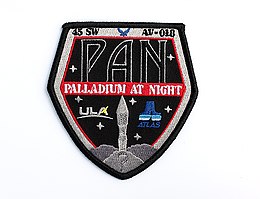


PAN mission patch
| |
| Mission type | SIGINT |
|---|---|
| COSPAR ID | 2009-047A |
| SATCAT no. | 35815 |
| Spacecraft properties | |
| Bus | A2100 |
| Manufacturer | Lockheed Martin[1] |
| Start of mission | |
| Launch date | 8 September 2009, 21:35:00 (2009-09-08UTC21:35Z) UTC[2] |
| Rocket | Atlas V 401 |
| Launch site | Cape Canaveral SLC-41 |
| Contractor | ULA |
| Orbital parameters | |
| Reference system | Geocentric |
| Regime | Geostationary |
| Perigee altitude | 35,778 kilometers (22,231 mi)[3] |
| Apogee altitude | 35,807 kilometers (22,249 mi)[3] |
| Inclination | 0.09 degrees[3] |
| Period | 1436.12 minutes[3] |
| Epoch | 10 January 2015, 14:22:18 UTC[3] |
USA-207,[4] international COSPAR code 2009-047A,[5] also known as PAN, officially meaning Palladium At Night,[6] NEMESIS I,[7]orP360[8] is a classified American SIGINT satellite,[7] which was launched in September 2009. The US government has not confirmed which of its intelligence agencies operate the satellite, [9] but leaked documents from the Snowden files point to the NSA.[10] The spacecraft was constructed by Lockheed Martin, and is based on the A2100 satellite bus,[6] using commercial off-the-shelf components.[8] The contract to build PAN was awarded in October 2006, with the satellite initially scheduled to launch 30 months later, in March 2009.[11]
PAN was launched by United Launch Alliance using an Atlas V 401 carrier rocket, with the serial number AV-018. The launch, from Space Launch Complex 41 at the Cape Canaveral Air Force Station, occurred at 21:35 GMT on 8 September 2009, at the start of a 129-minute launch window.[12] PAN successfully separated from the rocket just under two hours after liftoff.[13]
PAN has shown an unusual history of frequent relocations during the first 5 years of its operations, moving between at least 9 different orbital slots since launch. With each move, it was placed close to another commercial communications satellite.[7] From 2013 onwards it was located at 47.7 deg E., over East Africa, staying in that position for several years. In February 2021 it started a slow drift eastwards.[14]

|
| |
|---|---|
| January |
|
| February |
|
| March |
|
| April |
|
| May |
|
| June |
|
| July |
|
| August |
|
| September |
|
| October |
|
| November |
|
| December |
|
Launches are separated by dots ( • ), payloads by commas ( , ), multiple names for the same satellite by slashes ( / ). | |